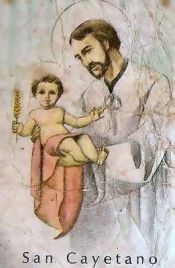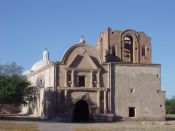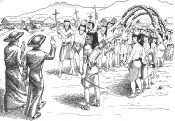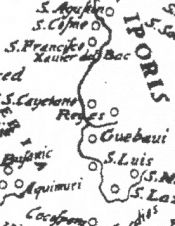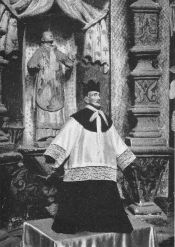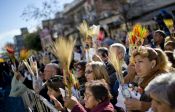San Cayetano - Saint Cajetan
Patron Saint of Tumacácori Mission
"Peace, Bread and Work"
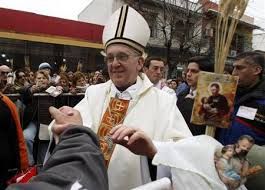
Pope Francis (Cardinal Bergoglio) & Pilgrims Honoring San Cayetano With Wheat
Padre Kino and San Cayetano
In additon to his devotion to the Jesuit missionary St. Francis Xavier, Padre Kino was devoted to San Cayetano. San Cayetano was a 16th century priest who lived in the greatest of humility as he ministered to the urban poor and advocated reforms which were later adopted by the Catholic Church.
During Kino's first major exploration beyond the Spanish frontier during the Christmas seaon, he accepted the invitation of the O'odham people and visited their village of Tumacácori in early January 1691. He named the village in honor of San Cayetano. Later he named its mission San Cayetano de Tumacácori. Like Kino, San Cayetano was a priest who ministered to the physical and spiritual needs of the very poor, lived in great humility and was invited to live in and minister to many villages and towns. Both Kino and San Cayetano are known for their giving of wheat and bread to the hungry and poor. For more information on San Cayetano's life and the devotion to him, scroll down on this page..
The events that happened during Kino's first expedition were very important to the next 20 years of his ministry in the Pimería Alta. The expedition started as an inspection tour by Kino's Jesuit superior, Padre Juan María Salvatierra. Padre Salvatierra received troubling reports from Spanish colonists that criticized Kino's work and questioned the necessity of his missions. The critics wanted Kino removed from the frontier so that Kino would no longer be able to protect the Native People from enslavement and the expropriation of Native lands by the Spanish.
At the village of Tucubavi before their planned return, the Jesuit missionaries were met by O'odham leaders living in the Santa Cruz River Valley - some had traveled as far as 100 miles away. They invited Kino and Salvatierra to visit their villages in today's Arizona. No European had seen these villages before. When the missionaries arrived at Tumacácori, they were greeted by the entire village who had prepared living quarters for them and a chapel to say Mass. Later in his inspection report, Salvatierra would described the O'odham as an industrious and peaceful people. He also wrote that he too wanted be a missionary to them. Kino had saved the missions. He would have do it many times again.
Kino introduced his gift of winter wheat to the O'odham as food and as seed to plant. Before Kino arrived, the winter months of the year could be a time of starvation for the O'odham. Kino's wheat provided year round food security to the O'odham.
Also during the first expedition an important step was taken in fullfilling in Kino's vision of the Jesuits restarting the missions in Baja California. Kino built the first mission in the Baja as part of a doomed Spanish colonization effort. This effort was abandoned over Kino objections. The Spanish faced starvation because Baja could not be supplied adequately. All the supplies including food had to be transported by ships over the unpredictable waters of the Gulf of California. Kino convinced Salvatierra as they rode on the trail that the Jesuits must return to the Baja to minister to its destitute people. Kino's vision was fulfilled ten years later by Salvatierra. Kino's wheat, cattle and other products from his prosperous mission farms and ranches would provide the necessary supplies to support the new Jesuit Baja missions.
San Cayetano was in Kino's thoughts and prayers when Kino named the Tumacácori village in the saint's honor and saved the existing missions for being closed. San Cayetano's rules for reform and the renewal of the pastoral lives of priests were a major part of Kino's Jesuit practice. When the Society of Jesus, the formal name of the Jesuit religious order, was founded in 1540, San Cayetano was ministering to the urban poor. The Jesuits incorporated many of San Cayetano's philosophies into their order's governing documents,
Jesuits adopted many of San Cayetano rules when the religious order was recognized in 1540. When San Cayetano was canonized Kino was a seminarian in Central Europe twenty years before. Also San Cayetano's feast day was either on or very near to Kino's birthday. Kino must have said many more prayers especially of thanksgiving to San Cayetano since many more important events in Kino's ministry occurred at the village named after this heroic saint.
On August 6, 1990, on the eve of San Cayetano's saint's day, the United States Congress created Tumacácori National Historical Park and gave the park more protection from its previous classification as a U.S. national monument.
In mid January 2016, the 325th anniversary of Kino's first visit to the village of Tumacácori was celebrated. Scroll down on this page for more about San Cayetano's life and the devotion to him.
Also the 50th anniversary of the discovery of the Kino's skeletal remains occured in May 2016. As part of the celebrations Kino Wheat was planted and harvested at the time of the anniversary. Many will shared the wheat stalks with others as is the tradition in Argentina at the time of San Cayetano's feast day which occurs within days of Kino's birthday. The people of Argentina greet each other on San Cayetano's feast day with the words "Peace, Bread and Work" For more information, click Kino Wheat Celebration.
Every August 7th, San Cayetano's saint's day is celebrated worldwide.
Editor Note
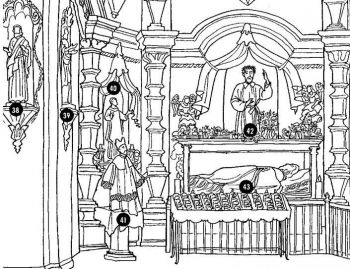
San Cayetano Statue (41) at Mission San Xavier Mission del Bac Until 1970s
San Cayetano Statue Returns To Tumacácori
More than a century after Kino's death the O'odham people of San Cayetano de Tumacácori abandoned their mission in 1848 after a series of attacks by marauding Native people who were their traditional enemies. The O'odham sought safe haven at Mission San Xavier del Bac. As they left, the O'odham people took the statue of San Cayetano and ten other statues from their beloved mission and walked with them tied to their backs 40 miles in a December snow storm that was colder than any of them could remember..
The O'odham people perserved the statues and also perserved Mission San Xavier Bac until the Franciscans returned in 1910. The statue of San Cayetano (number 41 above) stood on a pedestal to the right of the statute of the reclining St. Francis Xavier (number 43 above) in the West Chapel of the Mission until the 1970s. The parishoners of Mission San Xavier del Bac loaned their statue of San Cayetano to the Tumacácori National Historical Park where it is now on display in its museum. The O'odham people remember Padre Kino over 300 years after his death and continue to rever him. To view and download guide to statues of Mission San Xavier, cllck Statuary Guide.
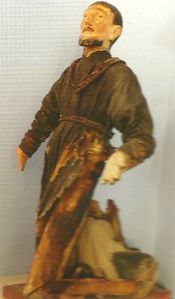
Charred Statue of San Cayetano
Rain Shower Saves Burning San Cayetano Statute
Encarnación Mamake, an elderly and blind Sobaípuri O'odham woman, recounts to Father Oblasser 80 years after Tumacacori was abondoned that a rain shower extinguished the flames of the burning statue of San Cayetano.
"Tumacacori belongs to us, too. It happened this way. The Apaches drove our kin folks from that mission. These wild people were going to burn the statue of St. Cajetano. The flames had already commenced to consume the image, when a shower extinguished the fire. This statue and many others were brought here by the women, who carried them in their Kiahats (burden baskets). "
"Carnación Tells Her Tale"
Bonaventure Oblasser, O.F.M.
Arizona Historical Review
January 1931 Vol. 4 No. 3
For entire article
click Carnacion
Plant, Grow and Share Kino Wheat
Honor Padre Kino and San Cayetano
People in the Pimería Alta planting Kino wheat in November through January so it can be harvested next May as part of the celebration of the annual celebration of the discovery of Padre Kino skeletal remains. There are many ways to share Kino Wheat. (Click Kino Wheat Celebration) One meaningful way is to incorporate the wheat sharing tradition of the people of Argentina as part of their celebration of San Cayetano's feast day. The people of Argentina great each other on the feast day with the words "Peace, Bread and Work"
Save your wheat stalks and give to them to others in August as a gesture of good will and wish of good fortune. Tell the recipient to hang the wheat stalk on the inside of the front-door of their home for the blessings of Padre Kino and San Cayetano. Both Padre Kino and San Cayetano were givers of wheat and bread. Padre Kino named the mission at Tumacácori in honor of the saint.
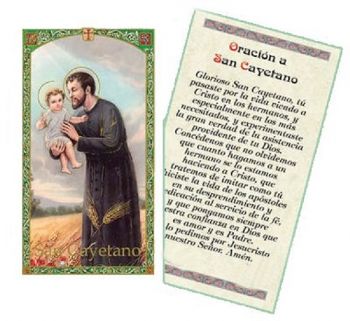
San Cayetano As Patron of Wheat and Bread - Prayer Card
Life of San Cayetano
San Cayetano (Gaetano dei Conti di Thiene) (1480 – 1547) is a 16th century saint who devoted his life to the care of the poor, sick and dying and to the reform of the Catholic Church during a time of great turmoil in Renaissance Italy. He is known as St. Cajetan Thine in English speaking countries.
San Cayetano was born in 1480 to aristocratic parents near Vicenza, 50 miles west of Venice, Italy. He received his university degree in civil and canon law. Before becoming a priest at age 36, he was a diplomat and lawyer for the Vatican for over ten years.
As a priest San Cayetano lived a life of extreme poverty and saintly humility. He gave away all his riches to help the less fortunate. He relied only on God and His Divine Providence. He did not acceptsalaries nor did he beg. San Cayetano relied for his livelihood.only on the good will of people who donated freely without being asked.
He established hospitals in Vicenza and Venice where he personally ministered to the physical and spiritual comfort of people with incurable diseases. He also founded nonprofit credit organizations throughout Italy that lent money to the poor to protect them against usurious banks and loan sharks who preyed upon the poor. Cities throughout Italy sought his ministry.
He was the founder of Clerics Regular (Congregation of Theatines), a new religious order whose rules were a guide to reform and renewal of the pastoral lives of the clergy and laity. These reforms were incorporated into the rules of other religious orders who sought needed reforms and were used as a guide by the Jesuits when they were estatblished. After his death, San Cayetano's rules were instituted by the Council of Trent which still govern today's Catholic Church. San Cayetano died in 1547 in Naples.
San Cayentano is prayed to by people who need his help because they are in extreme want or their lives are in ruin and they are in need of good fortune. In Italy his title is the "Padre della Providenza." He is the patron saint of wheat and bread givers, of those seeking employment and of literacy. Also he is the patron of priests who were lawyers.
In Argentina he is recognized as the country's patron saint and is known as San Ca. As part of his feast day celebrations novenas and pilgrimages are made. People greet each other with the words "Peace, Bread and Work." People give others stalks of wheat with his prayer card as a sign of San Cayetano's blessings in hope that next year will bring a better life especially for those who are down on their luck San Cayetano's feast day is celebrated on August 7th or the following Sunday after the feast day during the Southern Hemisphere's second month of winter.
In paintings and prayer cards, San Cayetano is depicted with the infant Jesus based on his vision of the Blessed Mother appearing to him on Christmas Eve and rewarding him for his devotion to Her by placing Jesus in his arms. As part of his devotion to Her, he began the Christmas tradtion of the nacimiento where other figurines are displayed as part of the nativity scene. At the Vatican, statues depicting him are prominently displayed in St. Peter's Basilica and on the colonnade in St. Peter's Square.
Padre Kino was devoted to San Cayetano. Padre Kino was the first to name a parish in today's United States in honor of San Cayetano at Tumacácori during Christmas season - twenty years after San Cayetano's canonization. Perhaps Padre Kino thoughts were of his past Christmas seasons with his parents and the family and the nacimiento navivity scene that San Cayento encouraged. One hundred years after Kino's death, San Cayetano's name was transferred by the Franciscan missionaries from Tumacácori to a new mission several miles away at Calabazas. Both mission sites are now part of the Tumacácori National Historical Park. Today a elementary school and a mountain range also honor him in Santa Cruz County, Arizona. Beyond Arizona there are parishes in Denver and Chicago named St. Cajetan - his name in English. The Theatine Fathers have their U.S. seminary in Denver and minister in 10 parishes throughout Colorado.
The heroic life of this saint is relatively unknown in the United States. He should be given greater recognition for his his courage and humility, work for the poor and his great contributions to the reform of the Catholic Church.
Interestingly, San Cayetano grew up with his cousin Luigi da Porto who later wrote the novel "Romeo and Juliet" which inspired the Shakespeare play.
Further Online Information about San Cayetano
The Life of St. Cajetan, Count of Tiene: Founder of the Theatines
D. Giuseppe and Maria Zinelli - 1753
Translator: Mary Elisabeth Herbert - 1888
Book in English translated from biography in Italian with great introduction by then Bishop of Salford.
In various downloadable formats:
Click
https://archive.org/details/thelifeofstcajet00zineuoft
San Gaetano
John Scerri
Website that contains detailed information and art on San Cayetano (San Gaetano in Italian) including a bibliography.
For Blog use St. Cajetan's Corner below. Blog on website is about interesting history of Malta.
Click
http://www.malta-canada.com/san-gaetano/Index-S-G.htm
St. Cajetan's Corner
"Peace, Bread and Work"
Author Unknown
Blog with latest San Cayetano news with prayers and art work.
Index to previous blogs is on right column of the page.
Click
http://stcajetanscorner.blogspot.com/
Theatine Spirituality: Selected Writings
William V. Hudon - 1996
Book in English includes writings and letters of San Cayetano and other Theatines
Google Book Preview with almost all of the book's pages.
Click on web address and then click on book cover to access preview.
https://books.google.com/books/about/Theatine_Spirituality.html?id=dE6HyBpgedsC
Santuario de San Cayetano de Liniers
Web Page
Spanish
Web page of Shrine of San Cayetano in the outskirts of Buenos Aires where over 25,000 pilgrims travel and pray on the feast day of San Cayetano.
Click
http://www.sancayetano.org.ar/index.php
Historia de San Cayetano de Thiene
Animated Video
Clérigos Regulares (Theatinos)
Biography of San Cayetano
Spanish
Minutes: 14:15
Click
https://www.youtube.com/watch?v=g7jJq44TVeo
Pope Francis' Message to San Cayetano Pilgrims
"Con Jesús y San Cayetano,
Los Necesitados Vamos al Encuentro de Los Más Necesitado"
"With Jesus and Saint Cajetan,
We Go to Meet Those in Most Need”
Video-message and text of message in Spanish and English translation sent by Pope Francis to pilgrims in Argentina on the 2013 feast day of San Cayetano.
Video Message
Pope Francis
Spanish
Minutes: 4:15
Click
https://www.youtube.com/watch?v=QY47R2ONhXQ
Spanish Text
Click
http://es.radiovaticana.va/storico/2014/08/07/con_jes%C3%BAs_y_san_cayetano%2C_los_necesitados_vamos_al_encuentro_de_los/spa-818020
English Translation
and article by the Holy See Press Office about the annual feast day traditions in Argentina.
Click
http://www.ewtn.com/vnews/getstory.asp?number=126398
